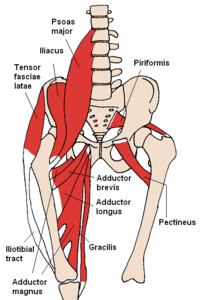muscular endurance as it relates to the muscles of the trunk and hips.
The muscles of the trunk and hips are ones that stabilize the spine, and all its related structures. If the spine is not held in alignment for long periods of time, tissues can get damaged, nerves can get pinched, discs can slip/herniate, etc - in short, an unstable spine = back pain.
So what do the muscles of the hips have to do with the spine? Well, the muscles of the hips are connected to the pelvis, which is the base of the spine. Many muscles connect the pelvis to the spine as well. Thus, it is possible to have a structurally healthy spine, but if certain muscles of the hips are too tight/too flexible, or too weak/too strong, the pelvis can be pulled out of alignment, which in turn will affect the spine as well.
A few illustrations showing how many muscles attach to both the spine and pelvis, or the femur (thigh bone) and pelvis. If just one of those muscles connected to the pelvis is too weak, tight, or loose, it can effect all the other connected structures!
Ok, so the spine, pelvis, and all connected muscles are interrelated. Why is endurance of the trunk and pelvis musculature important? We spend most of the day either sitting or standing up. That whole time, our spine needs to be held in proper alignment. All day. Every day. Hence, if those muscles that stabilize our spine are not able to work for long periods of time, they get tired, and can't hold our backbones or pelvis in the proper position anymore!
I've heard that just the abs (or psoas, or multifidus, etc) need to be strong to alleviate back pain. Is that not true? It is not just one muscle that holds our spine and pelvis in proper alignment - it is ALL of the muscles on all sides of our trunk and hips that do this work! If one muscle is weak, tight, or loose, it can cause problems, but one specific muscle doesn't do all the work for one task. Our back muscles, obliques (muscles on our sides), our abs, and a whole host of deeper muscles (such as the psoas or multifidus) must all work together to brace our spine in a healthy position.
Alright, so what exercises should I do to increase my trunk-hip muscular endurance? Isometric exercises (exercises where you don't move) or, what I have begun to call iso-dynamic exercises (ones in which you are moving, but are trying to keep a certain part of your body still) are just as good as any type of sit-up, crunch, or dynamic trunk exercise, and they might very well be more applicable to what we do in the real world. Lets elaborate:
Isometric exercises
The king of all isometric trunk and hip exercises is the plank and all its variations. You can also do bridges, which target the lower back and the gluteal muscles (your butt). Different types of planks target different areas of the trunk and hips, but they all force your muscles to hold your spine, hips, and/or whole body in a straight line. Make sure to do different types of planks to hit your trunk and hips from all sides!
Iso-dynamic exercises
As I said earlier, an iso-dynamic exercise is one where you are moving your whole body, while trying to keep one part or parts of your body from moving too much. Two examples are the bottoms-up kettlebell carry, and the overhead carry with a slosh bar. Both exercises invlove walking (the dynamic part), while your trunk and hips (as well as arms and shoulders) must hold the unstable load still while you are walking (the isometric part). This static action of the trunk and hip muscles makes them work, which braces your spine and holds it in proper alignment.
So whats the best way to go about adding exercises like these to my workouts?
Here are the two ways which I believe are best:
- At the end of your workout, do two or more sets of different plank/bridge variations. Along the same lines, at the end of your workout, do two or more sets of some kind of iso-dynamic exercise, carrying the load for as long a distance as possible. For the best results, do at least one type of isometric and one type of iso-dynamic exercise. Whichever one it is, you want to be able to do the exercise for as long as possible, since that is what endurance is. Therefore, you want to be able to hold that plank for as long as possible, or walk for the longest distance possible while carrying some kind of unstable load.
- At the beginning of your workout, do these exercises as part of a warm-up. By doing these exercises at the beginning of your workout, you "turn on" your trunk and hip muscles, and get them into "stabilization mode." Be careful though, as you don't want to fully fatigue those muscles before going through the rest of your workout. So you can still do two sets of isometric and iso-dynamic exercises, but don't go until failure. Dial the length of your sets back a bit so that your trunk and hip muscles feel worked, but will still last through the end of the rest of your workout.
The moral of the story: having good endurance in ALL muscles of the trunk and hips that stabilize the spine and pelvis is important, both for the reduction of back pain and for long term back and hip health!


No comments:
Post a Comment